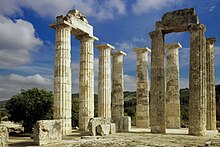Nemea


Nemea (Greek, Νεμέα) was the site of a sanctuary of Zeus and the site of the Nemean Games. It was located in the valley of the river of the same name, in the Argolis (Greece).
It was part of the territory of the polis of Cleonas, and later of that of Argos. It was located between the cities of Cleonas, about 5 km to the east, and Fliunte, about 8 km to the northwest. It currently gives its name to two neighboring towns in Corinthia: the town of Old Nemea and the municipality of New Nemea. The archaeological remains of Nemea are today located in the town of Old Nemea, while New Nemea is located two kilometers further west.
Mythology

Nemea is famous in Greek mythology for living in its forests a famous lion, which died at the hands of Heracles as one of his twelve heroic labors.
One tradition about the name of the valley says that it was named after the Naiad nymph Nemea, a daughter of the river-god Asopus, while another states that it was obtained from the Danaid Nemea, to whom it fell by lot. said valley in the division that was made of the Argolis between her and her sisters. Finally, there is a third tradition, which says that its name derives from the fact that Argos took his flocks to said valley to graze, in Greek νεμέθω.
It was said that Mount Apesas, which is located above the sanctuary of Nemea, was where Perseus made the first sacrifice to Zeus Apesantius.
The Lemnian Hypsipyle, who had been sold as a slave to Lycurgus and Eurydice, kings of Nemea, took care of their son, called Opheltes. But he had to guide the Argive army that was going to fight against Thebes to a fountain in the mythical episode of the seven against Thebes and, while he left the little boy on a tall celery bush, a snake killed him. After this event, the Argives instituted, in funerary tribute to the little one (whom they renamed Archemorus), the Nemean Games. Pausanias located the tombs of Opheltes/Arquémorus and Lycurgus in Nemea.
History
It is documented that Nemea hosted the Nemean Games from at least 573 BC. C., which were celebrated every two years, in the month of July and the winners received a crown of celery.
The inhabitants of Argos made sacrifices to Zeus in Nemea, so they had the right to choose one of the temple priests.
It was the scene of a battle in 394 BC. C. of the Corinthian War between the Corinthians, Athenians, Argives, Euboeans, Boeotians and other allies against the Lacedaemonians and their allies in which the latter won.
The games continued to be held in Nemea until around 270 BC. C. they moved to Argos. Aratus of Sicyon tried to have them revived in Nemea in 235 BC. C. Later they were held alternately in Argos and Nemea until the headquarters was moved to Argos permanently.
Archaeology
In 1776 a first small excavation was carried out in Nemea. More than a century later, the French Archaeological School carried out excavations during the period between 1884 and 1912. Between 1924 and 1926, other excavations led by the American School of Classical Studies took place. From 1973 to 1986 there was a new campaign carried out by the University of Berkeley (United States).
In the archaeological site are the ruins of the temple of Zeus, from the IV century BC. C., built on the ruins of a previous one of which only one of the walls is preserved. It is a hexastyle peripteral Doric temple, but it also has columns of the Ionic and Corinthian order.
The stadium is located about 400 m from the temple. It had a capacity for about 40,000 spectators.
There are also remains of an elongated altar where athletes took oaths and sacrifices before competing. In the archaeological site there are also several treasures, a hostel for foreigners (xenon), another for athletes, houses for judges and some public baths.
The material discovered in the excavations is exhibited in the Nemea Archaeological Museum, built by the University of Berkeley.
Contenido relacionado
Naji al-Ali
Stressed Out (A Tribe Called Quest song)
Parallel circuit